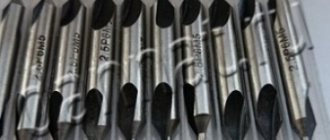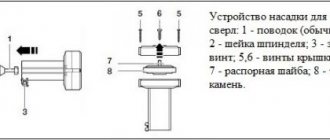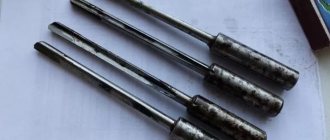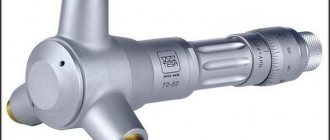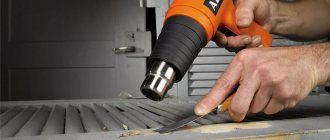A step drill is a universal tool for processing metal and plastic products. Its shape looks like a carrot or a Christmas tree. This is the difference from other metalworking devices: conical drills have a stepped design, which allows you to drill perfectly round holes of various diameters. Markings on the edges indicate the size of the section. Please note: the unit of measurement for this parameter can be either millimeters or inches.
When choosing a tool, pay attention to the type of material. Metal drills are subject to increased strength requirements, so their price is quite high.
Features and Benefits of Step Drills
The design of the product consists of two main parts:
- Working. The tip of the tool has a sharp shape. This eliminates the need for centering fixtures and allows you to work with the toughest materials. The finished hole does not require finishing with a needle file or grinder. The pitch of the steps depends on the type of tool and the size of the holes: up to 12 mm this figure is 1 mm, and over 12 mm - 2 mm. The minimum tool diameter is 4 mm, and the maximum is 38 mm. The standard step height is considered to be 5 mm, but drills with other sizes are available. Some manufacturers apply an abrasive coating to the working surface of step drills for metal - this increases the strength of the cutting edges and increases the sharpening interval of the tool.
- Drill shank. This part of the tool is fixed in the chuck. The shape depends on the type of drive mechanism. There are cylindrical, triangular and hexagonal shanks. The last two types prevent the tool from turning during operation. However, there is a downside: if the drill jams, there is a risk of injury to the operator.
Some users confuse step and cone drills. The difference lies in the shape of the working part. For conical tools, this is a series of step-by-step annular transitions and a longitudinal-spiral groove that has cutting edges. Thus, the size of the finished hole can only be adjusted using special stops on drilling machines.
Let's consider the main advantages of devices of this design:
- High accuracy. Using a classic tool does not allow you to drill a hole with smooth edges. This problem is especially acute when using drills with a diameter of more than 50 mm. The stepped design with smooth transitions allows you to obtain holes with perfectly smooth edges, regardless of the thickness of the material.
- Versatility. Having one drill replaces a whole set of tools. Simultaneously with drilling, chamfering is performed, which increases productivity.
- Ease of use. Marking the values on the body allows you to quickly select the desired diameter without using a caliper.
- Multifunctionality. With one drill you can process several types of surfaces: from wood or plastic to metal.
- Performance. Thanks to the use of high-quality materials, the drill can be used to process hard products without loss of quality.
Along with their advantages, the tools have a number of disadvantages. The high price and complex sharpening technology is a deterrent for some consumers. Professionals note that when drilling holes with a diameter of up to 15 mm, there is a slight decrease in accuracy.
Features of Step Drill
In everyday life, a conical drill with steps is called a “carrot” or “stepping”. The tool has a specific structure in the form of translational channels. Each subsequent channel has a larger diameter. The transition is 35–45 degrees.
The stepped structure increases the efficiency of drilling thin metal by 50%. The cutting ability of the drill is enhanced and the smoothness of processing is significantly increased.
Photo of step drill:
The tip of the cone consists of a tip for pre-drilling, a first bevel that removes burrs, and a special cutting edge that widens the hole.
To increase cutting capabilities, steel is often coated with an abrasive coating - titanium or diamond chips.
Application area
Step drills are used to process various materials:
- ferrous and non-ferrous metals;
- wood;
- plywood;
- plastic;
- drywall.
The device works best when drilling sheet-shaped workpieces. In addition, drills are used as a means of preparing holes in large parts and structures. In this case, the drilling depth should not exceed 6 mm.
The original shape allows you to obtain high-quality holes without irregularities and burrs. When moving to the next step, automatic chamfering occurs.
Inexperienced craftsmen believe that cone drills are difficult to find use in everyday life. In fact, such devices are guaranteed to be useful in the household, especially during renovations. Step drills are an indispensable tool when installing electrical wiring. With their help, it is convenient to drill holes in the profile (0.5–0.7 mm thick) for pulling the corrugation. Using any other device will result in the metal being bitten, which will pose a risk of damage to the entire structure. The drill will also come in handy when installing new devices, when there is a need for an additional hole in the electrical panel, the thickness of which does not exceed 1 mm.
Advantages and disadvantages
Step drills could be called ideal if not for a couple of negative aspects.
Recommended: Squeeze and Snap: 30 Creative Uses for Clothes Pegs
Let's start with something pleasant. Step drill:
- gives perfectly clean holes with a small material thickness;
- performs several operations at once: drills, chamfers, cuts, grinds;
- has several drill diameters in one;
- the sharp tip easily penetrates the material, regardless of its density and structure;
- can be used in drilling tools with automated and manual drive;
- As a rule, it is characterized by increased strength and does not dull for a long time.
Step drills have few disadvantages, but all are quite significant:
- High price. A high-quality nozzle costs 2000 rubles. and higher. The cost is determined by the quality of the steel, the presence of spraying, the brand, as well as the operating range. The more diameters, the higher the price. The cheapest Chinese nozzles cost from 400 rubles.
- The device is ineffective in situations where you need to drill holes in materials thicker than 6–10 mm.
- Requires careful handling. Great force, misalignment, or a fall from a height can lead to deformation. Then all higher diameters will become unavailable.
Types of step drills
Let's look at existing types. Conical drills for metal are distinguished according to the following parameters:
- Minimum and maximum diameter. There are tools for drilling holes up to 58 mm.
- Material of manufacture.
- Shank shape: round, triangular or hexagonal.
- Number and pitch of steps. Multi-stage drills offer the user greater freedom of action.
- Type of protective coating.
- The strength of the processed material.
Two-stage drills are classified as special tools. They are usually equipped with a countersink for a cylindrical or V-shaped screw head.
Number and shape of working grooves
An interesting feature of the device in question is the determination of the number of cutting edges. This parameter does not depend on the number of steps, since the cutting part is located on the grooves of the cone. In addition, they perform the function of removing chips during operation.
There are three types of grooves, which differ in shape:
- longitudinal;
- straight;
- spiral
Each design has its own advantages. For example, a straight edge lends itself much better to straightening and sharpening, while a spiral shape promotes softness and smoothness. This is the type of tool that is recommended for drilling thin-walled materials.
The quality of processing at high and low speeds depends on the number of grooves.
Eventually
Quite often, the reason why craftsmen refuse to buy stepped cone drills is precisely the high cost. After all, no one is spared the risk of purchasing a low-quality instrument or a counterfeit. That is why, in order to get a truly reliable device for drilling holes of different diameters, you should contact trusted suppliers and manufacturers. As a rule, the quality of products in this category is confirmed by appropriate certificates and special markings.
Marking
As an example, we use a cone drill Ø4-15/2 HRC 61±2. Explanation:
- 4 – minimum hole diameter;
- 15 – maximum size;
- /2 – step size change is 2 mm;
- HRC 61 – the material used is high-quality steel with a hardness of 61 on the Rockwell scale;
- ±2 – permissible error.
The grade of steel from which the device is made is applied to the surface of the tool. We recommend using products with HSS engraving. This means that the tool is made of high-speed steel, designed to operate at high speeds.
Self-sharpening
Only the cutting edge (groove) is sharpened.
It is prohibited to sharpen the transitions of step drills, as this leads to a change in the geometry of the working surface and the formation of burrs during operation. Improper sharpening leads to a decrease in the quality of the tool, often to complete disrepair. The long service life of conical drills requires periodic re-sharpening. At home, drills with a straight translational groove are the easiest to use. This is done manually using abrasive rods, diamond stones for knives or sandpaper.
Any home craftsman needs to know how to sharpen a step drill for metal with a spiral flute. The process requires the use of sharpening machines, on which the drill is directed so that the abrasive wheel passes exclusively in a spiral. For simultaneous smooth rotation, special devices are used; feeding the drill manually is highly not recommended.
Sources
- https://pressadv.ru/metally/kak-zatochit-stupenchatoe-sverlo.html
- https://TehnoPanorama.ru/instrumenty/stupenchatoe-sverlo-kak-zatochit-i-pravilno-sverlit.html
- https://gazsnabstroy.ru/prochee/kak-zatochit-stupenchatoe-sverlo-po-metallu
- https://steelfactoryrus.com/kak-zatochit-konusnoe-stupenchatoe-sverlo/
- https://ooo-asteko.ru/kak-zatochit-stupenchatoe-sverlo-po-metallu/
- https://remoskop.ru/stupenchatyie-i-konusnyie-svyorla-po-metallu-ekspluatatsiya-i-zatochka.html
- https://SdelaySam-SvoimiRukami.ru/7469-3-sposoba-zatochit-stupenchatoe-sverlo-v-domashnih-uslovijah.html
- https://master-pmg.ru/raboty-po-metallu/kak-zatochit-stupenchatoe-sverlo.html
- https://generator98.ru/metally/kak-zatochit-konusnoe-stupenchatoe-sverlo.html
How to choose a cone drill
When considering models from various manufacturers, we recommend using the following tips:
- Read in detail the characteristics of the stepped gimlet. Some models are better suited to working with metal than other materials.
- Pay attention to the color of the product. A gray tint indicates that no finishing operations were carried out on the tool to increase its performance characteristics. Gray gimlets are very fragile - they are not recommended for use when processing products with high strength. A black tint indicates the presence of an oxide film formed by steam heat treatment. The light golden color indicates that the product has been hardened and then tempered. This procedure is carried out to relieve stress and reduce the brittleness of steel. The bright golden hue is characteristic of the highest quality gimlets with a titanium nitride finish. This element copes well with drilling durable materials and non-ferrous metals. Wear-resistant coating guarantees long service life.
Products made from steel alloyed with cobalt are placed in a separate category. The cost of such models is 3-4 times higher than analogues. In return, the user receives a high-quality product that is resistant to high temperatures, which allows parts to be processed at high speeds.
- Study the size and labeling of the product.
- The final choice is influenced by the reliability of the tool manufacturer. Proven brands will be discussed below.
- Possibility of sharpening. Such a tool will last much longer than a regular one. The service life also determines the high cost.
Popular manufacturers
There is a wide range of step drills available in the market in varying qualities. Let's look at the most famous manufacturers of drilling tools:
- Bosch. A German brand whose product quality has stood the test of time. The cost starts from 3 thousand rubles.
- Makita. The Japanese manufacturer of high-quality equipment offers consumers products in various price categories, starting from 1 thousand rubles.
- Haisser. Brand from China. Specializes in the production of hand and auxiliary tools. Thanks to special additives, drilling accessories can be used in the most difficult conditions.
Those who are looking for the optimal price-quality ratio should pay attention to the products of Zubr and Enkor. The products of these manufacturers have long been able to compete with leading brands.
The high cost often scares off potential buyers, despite the fact that a quality product can recoup all costs in the long run.
Checking the sharpness of the drill
After a visual inspection shows that the cutting edges are smooth and sharp, check whether the correct sharpening angle of the metal drill is maintained and whether the length of the working edges meets the standards. To evaluate, you will need a special template, a protractor or protractor, and a caliper.
Checking the length of the cutting edges with a caliper
What parameters need to be checked?
- Is the angle of the cutting edge tilted forward? The presence of such an error makes the cutting edge not the highest point of the tooth and forms a hill on the back surface. This causes the drill bit to rub against the back surface of the material and not drill. The error is corrected by sharpening the drill again.
- Are the lengths of the cutting edges consistent from the center point on the web to the side apexes of the cutting edges? This distance must be the same on both sides, otherwise the diameter of the final hole will be larger than the nominal value.
- Check that the apex angle is 120°. You can determine the sharpening angle of a metal drill using a purchased or homemade template. It is important to ensure that the apex angles match for both teeth, otherwise only one side will work.
Correct and incorrect sharpening of a drill
After checking the basic parameters, drill into any metal workpiece. If the sharpening is done correctly, the drill will smoothly enter the metal, and the chips will evenly exit the grooves on both sides. And the finished hole will exceed the nominal diameter by no more than 0.05–0.1 cm.
After drilling the workpiece, sharpen the jumper to reduce the force applied during operation and reduce tool wear.
How to make a template for checking drill sharpness?
A template for checking the sharpening of a metal drill can be made independently from sheet steel or tin. You can take a template from the store as a guide. The simplest template can be made from two or three nuts. Nuts are ideal for these purposes, as they are regular hexagons with internal angles of 120°. If the nuts are connected, the angle between their faces will also be 120°. The nuts can be welded or glued to each other using hot glue.
Taper shank drill - a modern take
Modern conical drills are made of durable carbon or alloy steel. Manufacturers often use additional heat treatment of the surface of these tools during manufacturing. This makes them more reliable and at the same time protects them from corrosion. The tapered shank design helps improve productivity and hole quality. Thanks to this shape (conical), the drill easily comes out of the material being processed.
As a rule, such drills are used to make various holes on a metal surface. They can also be used when holes are required on plastic, duroplastic or sheet steel (a conical stepped drill does an excellent job of this). The diameter of the shank or cone can range from 6 to 12 mm. And the cone length is possible from 58 to 85 mm. Drills are selected depending on the diameter and depth of the future hole.
Recently, craftsmen are increasingly using a spiral drill with a conical shank (GOST 10903-77) in their work. Usually he creates holes in various parts using stationary machines. The size of such drills can be from 5 to 80 mm. The tapered shank helps to significantly increase the surface area of contact between the drill bit and the head. This in turn helps not only to increase accuracy, but also to increase the reliability of fastening.
Today, twist drills can be long, solid carbide, special for processing light alloys, difficult-to-cut materials, and can also be additionally equipped with carbide inserts. This division of these tools allows you to more accurately select them for certain types of work. This will help improve not only the drilling process itself, but will also make the entire job better.
Benefits of the tool
One of the most important factors in the drilling process is the accuracy of tool placement. The stepped design of the drill ensures self-centering and greatly simplifies processing. In addition, step drills have a number of other advantages:
- Perfectly round hole shape when drilling thin sheets.
- Universal application. One tool can drill holes of different diameters.
- Save time. There is no need to change the drill to consistently increase the hole diameter. One pass is enough for this.
- Fast and smooth chip removal.
- Possibility of chamfer cutting along the edge of the hole.
Design and types
Cone devices consist of the following elements:
- conical working surface;
- the tail part, with the help of which the tool is attached to drilling machines and drills, markings are applied to it;
- pointed end for smooth passage of the drill into the material.
Based on the type of cutting surface of the tool, there are two types with different characteristics:
- Straight edge. No additional equipment required for sharpening. Processes the material softly and smoothly, without jerking.
- The spiral edge allows you to drill thin workpieces and soft materials.
The tool is made from steel with a high carbon content. Working surfaces are coated with titanium and diamond chips. As a result, the service life of the tool increases and the need for constant restoration of the cutting edge is reduced.

